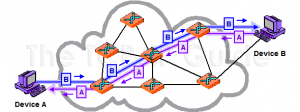July 31, 2017
There are things, like drinking to excess, that one does and, while you’re in the throes of worshipping at the shrine of the Porcelain God, your brain goes: “Right! NOW I REMEMBER why I haven’t done this in a decade…”
I had the same experience over the weekend trying to move my companies’ hosted VOIP from Cox to AT&T. But with no technicolor yawning.
Over time, one forgets the essential differences between:
- A consumer vs. tariff-controlled provider
- Who is allowed to make changes to your circuit provision (You, the customer vs. their company rep)
- The quick flexibility of a coax broadband provider, who answers to the end consumer and thus has an enormous and readily available fleet of trucks and back-end folks, vs. an organization that grew up not doing IP, but switched copper networks, where circuit provisioning takes time.

We installed AT&T’s 10×10 fiber product back in February of 2015. We had originally specified putting VOIP on this circuit (the lack of latency and jitter in a fiber product is stellar), but since we already had our VOIP system working fine on a Cox static IP, we said: “we’ll do it later — sometime.”
Well, later became slightly more important this last week, when Cox outages at our place got bad enough to focus our attention. With the 2017 Campaign approaching after Labor Day, we wanted to make sure our phones would work, without failure, at the communities’ most critical time fundraising-wise.
After replacing the Cox modem 4 times since 6/28, last Friday they pulled a new coax from the box outside to my telco rack. We’ll see: cross fingers.
As you can see, no Internet Service Provider is totally blameless in this story.
But my bullet points above only scratch the surface of the issues and differences between these providers, and it’s nothing new. This October 1996 WIRED article “Netheads vs. Bellheads” describes the battle that’s been going on for years. The particular product names may change, but the point is one of organizational culture. All the Baby Bells still have a great amount of copper-based, powered, and circuit-switched stuff out in the field they have to support. They’re trying to get out of the copper wire business as fast as they can, but after over 100 years it takes time. As the article suggests then, the mindset of doing things in an Internet Protocol (IP)-derived world is different.
We all know that the world of IP is not circuit-switched (ATM), but packet-switched. The original DARPA-created Internet was designed to learn the network each time it sent out packets — the Cold War Era plan of building a network resilient to nuclear attack, where perhaps some network nodes were suddenly gone, forces network devices to “route around damage” as the famous saying goes.
So we now have our AT&T authorized agent who submitted a change order last Friday to open up the ports necessary for VOIP service. AT&T received it Monday, and it could be as long as 2 weeks before we can try again to make the switch. It’s not pretty, and one forgets that here, in the early 21st Century, that certain providers work this way. Until the next time.
Funny story about Internet convergence and switched networks: Around 2004, a client of mine (whose office was a few blocks away from where I sit now) was getting a T1 connection. The day of the evaluation with SWBell came, and I arrived to see a gaggle of engineers in the alley, all looking up.
The alley was paved with brick, from Tulsa’s early days. They said that the copper on the pole was from the same period; approx. 1922.
“Oh,” I said. “Does that mean you’re going to have to replace it for the T1 service?”
“Oh, no,” they said. “We can condition the line and it’ll work fine.”
And it did. Eighty-two-year-old copper, running 1.54Mbps Internet.